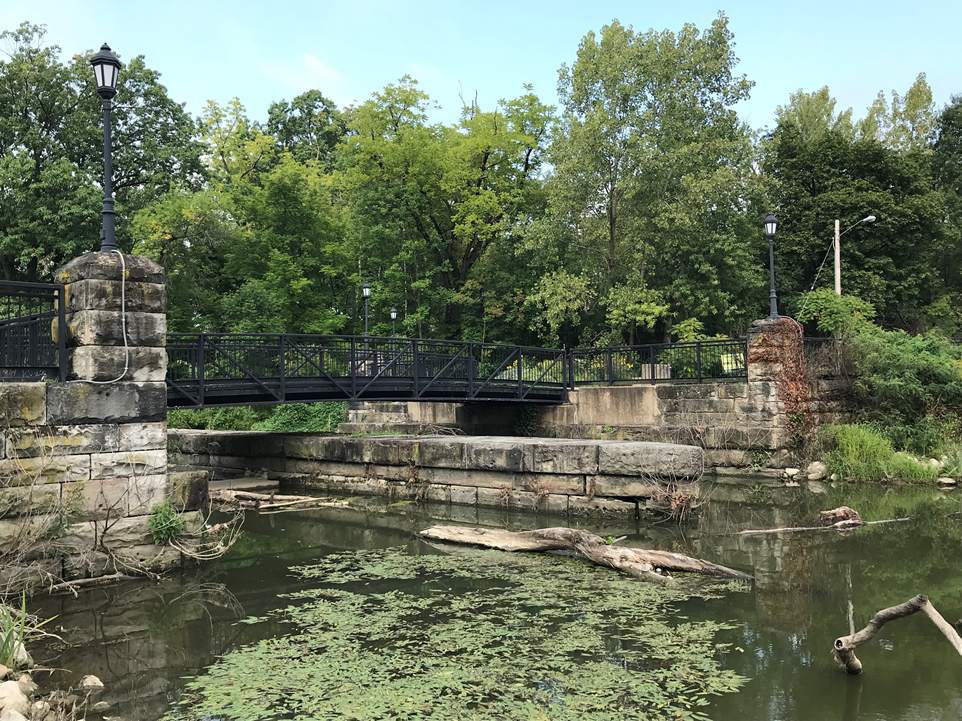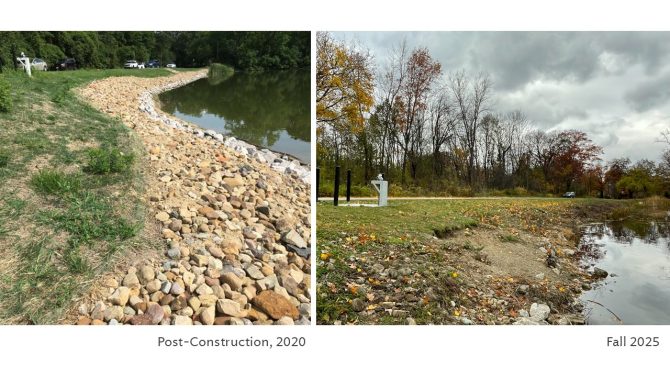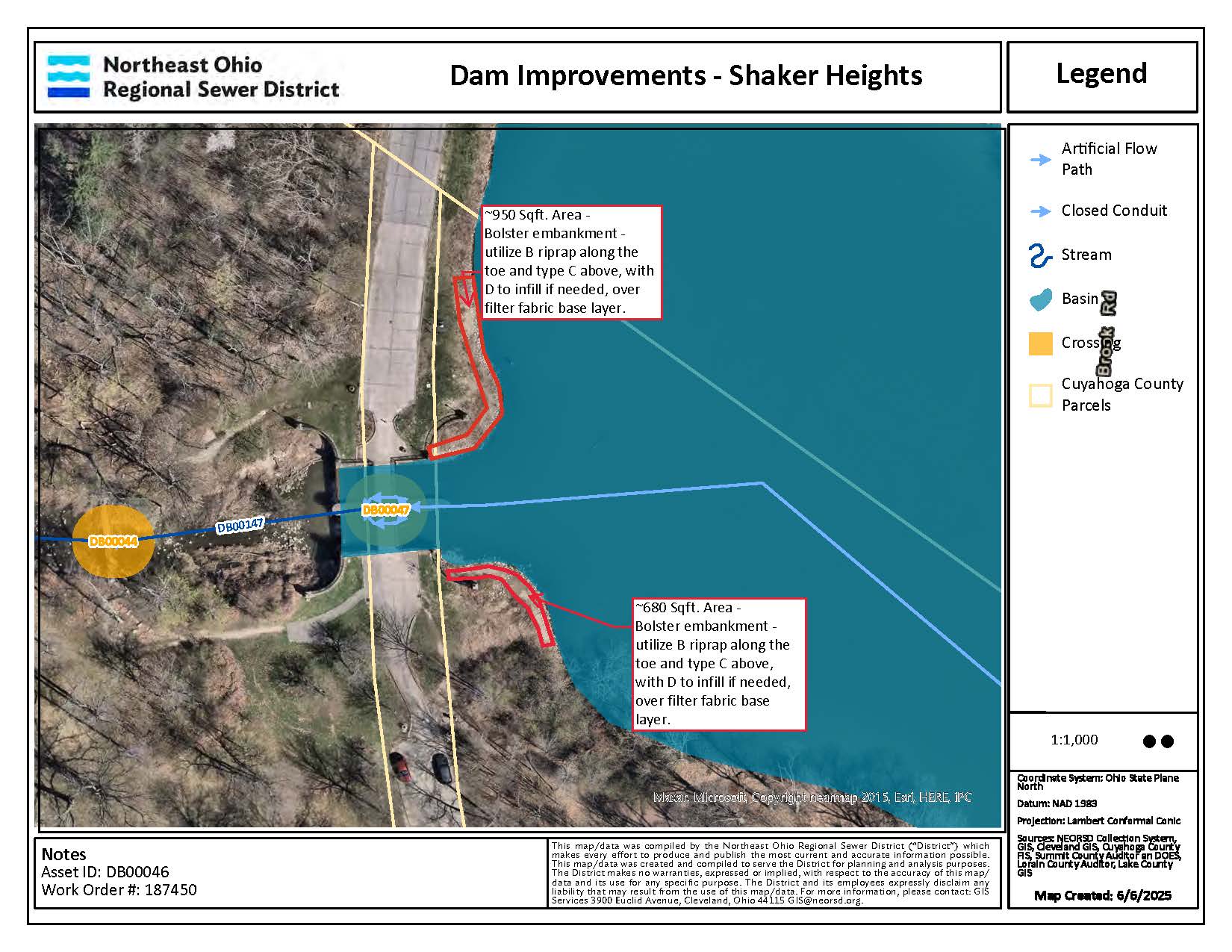Lower Shaker Lake Project
UPDATE July 23, 2025 | Our Lower Shaker Lake Dam Reconstruction Project page has been archived. It remains available, but is no longer actively updated. This page, Lower Shaker Lake Project, is the new destination for Lower Lake-related updates.

The Sewer District continues working to determine the best outcome for Lower Lake dam on Doan Brook, as the Brook flows from the Heights area downstream through University Circle, into Rockefeller Park and out to Lake Erie. Flooding occurs during larger storms in the University Circle area near Case Western Reserve University. This update provides a summary of our recent work.
December 2025 updates
Posted December 5, 2025: About the planned maintenance at Lower Lake Dam
The Northeast Ohio Regional Sewer District has contracted with Nerone and Sons to perform routine maintenance work at Lower Shaker Lake Dam. They are maintaining riprap, on the upstream face of the earthen dam, originally installed in 2019 to address deficiencies identified by the Ohio Department of Natural Resources (ODNR).
Over time, some of the riprap installed to provide erosion protection to the embankment has been displaced. The current work will place riprap within the limits of the previous project for the purpose of erosion protection.

Above: The upstream face of the Lower Shaker Lake Dam, as seen post-construction in 2020 compared to 2025 conditions. The work identified in our December 2 post is preventative maintenance that would feature larger stones.
Maintenance of the Dam
This work is part of the Regional Stormwater Management Program’s routine inspection and preventative maintenance process, necessary to help prevent erosion of the earthen dam and thereby reduce the risk of an uncontrolled breach.
Maintenance work at Lower Shaker Lake Dam is not related to our recommendations to the Cities of Cleveland Heights and Shaker Heights to address overall ODNR non-compliance by removing the dam and restoring Doan Brook.
Public Safety is Important
ODNR has determined this dam is non-compliant with Ohio’s dam safety standards. The work noted in our December 2 post and communicated to Cleveland Heights and Shaker Heights is crucial to help prevent erosion of the earthen dam and thereby reduce the risk of an uncontrolled breach. A breach of this nature would threaten downstream assets in University Circle and potentially cause loss of life.
Permitting Information
Proper maintenance is a condition of Nationwide Permit #3. Therefore, we are performing routine maintenance activities on previously installed riprap in compliance with our 2018 USACE permit. There are no adverse effects to historic resources or endangered species habitat from this work. This work complies with our USACE permit.
Timeline
The need to perform maintenance on the previously-installed riprap was identified as a result of a Sewer District inspection in June 2025. Planning and coordination with the Cities took place during the summer and fall months. While not an emergency repair, this work should be completed as soon as practicable to help prevent further erosion of the earthen dam.
Posted December 5, 2025
UPDATE: The Lower Lake Dam repair work noted below in our December 2 post will not mobilize today, December 5. We will provide an update to the schedule when it becomes available.
Posted December 2, 2025
In 2018 and 2019, the Northeast Ohio Regional Sewer District, with support from Cleveland Heights and Shaker Heights, received permitting and sought a contractor to place riprap (large rock) along the embankment at Lower Lake Dam. This work was completed to help stabilize and maintain the earthen embankment. Over time, some of that riprap has been displaced.
As part of the Regional Stormwater Management Program, the Sewer District’s Stormwater Inspection and Maintenance team has contracted with Nerone and Sons to replace washed out riprap along the upstream side of the embankment at Lower Lake. This work is critical to maintaining the existing earthen dam.
The contractor will add a filter fabric base and rip rap where washout has occurred since the original project in 2018. About 100 tons of rock will be installed along 226 feet of the upstream embankment on both sides of the principal spillway. From a permitting perspective, work will be performed under the original Nationwide Permit 3 issued on January 22, 2018, under DA No. 2016-01373, since this is considered maintenance of that previous work.
Our contractor plans to begin maintenance work at Lower Shaker Lake on Monday, December 8 to replace the riprap on the upstream face of the dam. This work is weather-dependent, but the tentative schedule is noted below, subject to change. We will notify Cleveland Heights and Shaker Heights if schedules shift.
- Nerone anticipates mobilizing and beginning staging on Brook Road on Friday, December 5
- Work expected to last 3-5 days (weather permitting)
- ~100 tons of riprap to be placed (see map below)
- Our Doan Brook Watershed investments summary (2015-2025) is a helpful resource for more information.

September 2025 updates
Posted September 25, 2025
During the week of September 29, our consultant subcontractors, C&K, will perform a CCTV inspection of the lake drain at the Lower Shaker Lake Dam to provide a visual assessment and confirm there is no seepage, structural or piping issues which can erode the surrounding soil and undermine the earthen dam embankment.
The inspection will require a temporary one-day parking restriction near the lake drain at some point the week of September 29. The exact date of the inspection will be weather dependent because C&K will need to do this work when the lake drain is closed. You may see C&K trucks on site at the dam during the week.
If you have any questions about this inspection or the methods involved, contact our Watershed Team Leader Cisco Rivera.
Posted September 4, 2025
Following our extensive public engagements the week of August 18, we continue to engage the cities Cleveland Heights, Shaker Heights, and stakeholders regarding our recommendation. We will share updates as they become available, and we welcome any questions from residents or interested customers.
Watch: Lower Shaker Lake Project Q&A
Updated September 2, 2025
Over the course of our August engagements, we answered a number of resident questions that followed common themes across both Shaker Heights and Cleveland Heights communities. We’ve created a YouTube playlist of these common project questions and our answers, featuring 13 brief clips on topics including project history, our data advancements and analysis, Ohio Department of Natural Resources dam safety, and much more.
August 2025 public engagements
Our August 19, 2025 public webinar was recorded and available for viewing, along with the Powerpoint slide deck. Our Project Open House was offered Wednesday, August 20 (11:00 a.m.-1:00 p.m. or 5:00-7:00 p.m.) at the Lee Road Library at which we welcomed close to 100 residents to talk more about the recommendation.
In 2021, we completed stormwater master planning under our Regional Stormwater Management Program to identify flooding and streambank erosion problems along Doan Brook and to develop potential solutions. During that phase of master planning, we noted that Horseshoe Lake dam and Lower Lake dam, both of which are Class I High Hazard dams, were out of compliance with Ohio Department of Natural Resources’ (ODNR) dam safety requirements and would need to be rebuilt to current standards or removed to address non-compliance deficiencies. This responsibility to resolve ODNR dam safety program non-compliance deficiencies falls to the Cities of Shaker Heights and Cleveland Heights as the dam operators for both dams. The City of Cleveland is the property owner at both Lower Lake Dam and Horseshoe Lake Dam. Additionally, at that time, our stormwater models showed that the Lower Lake Class I High Hazard dam had notable benefit to reduce the flooding in University Circle, while the Horseshoe Lake Class I High Hazard dam did not have notable benefit and could be removed. With these findings, we began the Doan Brook Restoration at Horseshoe Park project in 2022, which is now nearing 100% design and construction will begin in 2026.
In 2023, the Sewer District began the pre-design process for the reconstruction of the Lower Lake Class I High Hazard dam to better understand how the dam could be reconstructed and the potential impacts to the park landscape. During our pre-design of the Lower Lake Class I High Hazard dam, the detailed design of the Doan Brook Restoration at Horseshoe Park project, other updated stormwater modeling, and continued partner coordination, we learned the following about Lower Lake Dam:
- No longer notable flooding benefit: The flood reduction in University Circle from the Lower Lake Class I High Hazard dam reconstruction is no longer considered notable. With updated stormwater models, we now know that the flood reduction benefits for specific buildings and roadways in University Circle are limited.
- Greater impacts to aesthetics: Rebuilding the Class I High Hazard dam at Lower Lake to meet ODNR requirements had significant impact on the park landscape, drastically changing the feel of the area due to the required concrete flood walls and a new 167-foot-long auxiliary spillway.
- Opportunity for flood mitigation via conveyance: Additional conveyance capacity for Doan Brook flowing through University Circle was something that the Sewer District identified during the initial stormwater master planning process in 2021. However, at that time, construction seemed impracticable due to several constraints. Through continued collaboration with our stakeholders in this area, we learned that the Cleveland Museum of Art (CMA) is redesigning the Wade Lagoon area within the CMA’s Fine Arts Garden. This redesign would provide us the opportunity to reduce downstream flooding in University Circle by installing an additional culvert pipe under the Wade Lagoon to convey more flow from Doan Brook underneath University Circle. Based on the updated modeling, this additional capacity will reduce the flooding in University Circle.
- Balancing Risk, Cost, and the Environment: We take our responsibility to our communities and the environment seriously. Decisions about dams, especially Class I High Hazard dams, involve risks, like probable loss of life and also carry environmental impacts. We know through research that dams disrupt stream function and impact water quality and the organisms that live in the stream. When considering long-term planning, Class I dams also require ongoing maintenance, eventual replacement, and still carry some risk of failure. Our original direction of dam reconstruction was based on flood mitigation, but as data and new analyses were refined, we confirmed that the dam would not improve flooding to the extent that we previously determined. In light of this information, we are adjusting our recommendation to better reflect the new data and our long-term commitment and responsibility to the watershed.
Our recommendation: Remove Lower Lake Dam, and further restore Doan Brook
By removing Lower Lake dam, the Cities of Cleveland Heights and Shaker Heights can eliminate the public safety threats of probable loss of life and damage to public infrastructure and property during a catastrophic failure or uncontrolled breach of the dam. Restoring Doan Brook within its historic stream valley can solve the roadway flooding at North Park Boulevard and Coventry Road while providing an ecological uplift to Doan Brook’s water quality and continued protection of the cultural and historic resources associated with the Lower Lake landscape.
After taking these factors into consideration, the Sewer District believes removal of Lower Lake Dam and restoration of Doan Brook through the current lake footprint is the best path forward. Stay tuned for more information as we plan to host a webinar to share our findings, further explain the rationale to this recommendation, and discuss any questions you may have.
This is a Regional Stormwater Management Program #FeaturedProject.
